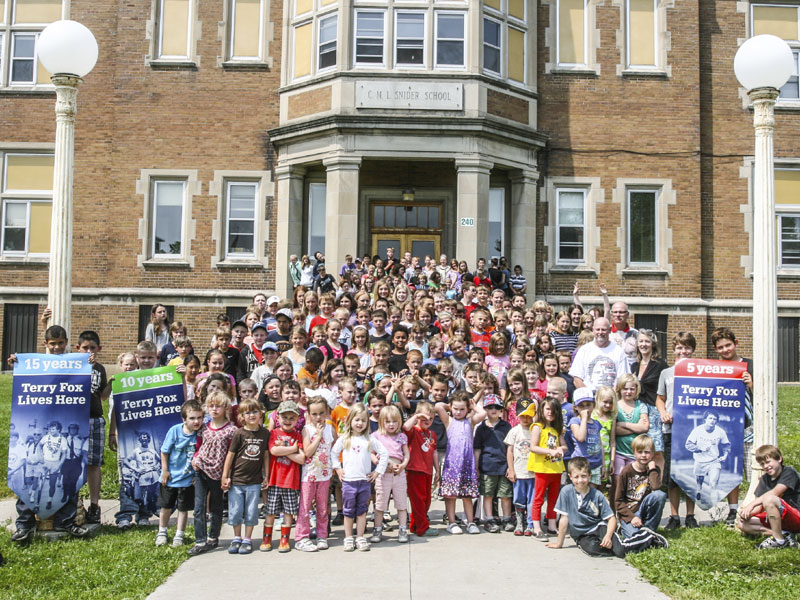County News
End of school


Service groups, organizations, businesses and individuals gather in 2011 to celebrate the rehabilitation of the athletic track at CML Snider Elementary School in Wellington.
Public board plan spells the end of at least four County schools
Enrollment in elementary and secondary public schools across the Hastings and Prince Edward District School Board has drifted lower over the past decade, a function of an aging population and smaller families, a trend seen both provincially and in this region. In fact, the local district board has seen a 21 per cent decline in student population at the elementary level and 26 per cent fewer in secondary schools. Some schools, including Pinecrest, Queen Elizabeth and Sophiasburgh in Prince Edward County, have more spare capacity than space currently occupied by students.
The average age of the board’s schools is 54 years and many need significant capital renewal—estimated at more than $250 million.
In response, the public school board has planned for three scenarios to “right size” its schools to its smaller population.
The Long-Term Capital and Accommodation Plan released last week has aroused considerable anxiety across the County at the prospect of closing schools.
The first scenario would see the closing of all but three elementary schools in the County. In this arrangement, one school would remain in Picton, another, presumably in Cherry Valley, would serve students in the south part of the County and a third, likely Kente in Ameliasburgh, would remain to serve the north and west parts of the County.
In its second scenario, all County public students would travel to Prince Edward Collegiate Institute (PECI) in Picton. The facility is currently not large enough to accommodate grades K to 12. For this scenario to work, a significant building addition would be required.
The third scenario imagines a variation that would see PECI become a kindergarten-to-grade-12 facility, but rather than building an addition, two or three elementary schools would be maintained.
Many individuals, organizations and businesses in Wellington are eyeing scenario three as the only workable option, with CML Snider remaining a core part of the community.
“CML Snider School is much more than an education centre in our community,” wrote Evan Nash in his submission to the public school board last week on behalf of the Wellington District Business Association. “It serves as an important social and recreation hub that is vital to the interests of business, entrepreneurs and investors in this village.”
He noted that the community—through individuals, business and service organizations—has raised hundreds of thousands of dollars to support facilities, amenities and programs at the school and remains committed to participate in the renewal of the school in Wellington.
Nash noted, too, that the board’s projections point to a moderately increasing enrolment in Wellington, adding that the village is poised to grow.
“Home sales have increased by more than 25 per cent over the past year,” said Nash. “Currently, three developers have new subdivisions ready-to-go, representing nearly 750 new homes in the village.”
The village business association leader says this growth potential must be factored into the board’s decision-making.
“The village and area has seen a surge in recent years of young families settling in the Wellington area—in large part because of the school in this community. Threat of closure will surely staunch this flow, posing a threat to the viability of the growing number of businesses and services that depend on a year-round community with which to serve.”
Anthony Lemke and his wife, Maria Gacesa, live in Wellington with their three young children. They moved to the village in large part because of the proximity of the school. Lemke argues the village and its surroundings are, in effect, part of the rich educational experience available uniquely in Wellington.
“Walk north for a couple hundred metres and you’re in the middle of cornfields,” wrote Lemke. “Walk south the same distance and you’re on the shores of Lake Ontario. Walk east along the main street from CML Snider through the village and you hit the beach, the marina and wetlands teeming with life. Walk west and you hit the commercial strip of the village, the trout stream, the community park, the churches. Also within walking distance of the school: three clay baseball diamonds, a 1,000 seat arena and tennis courts. It’s a full and vibrant community and the kids are a part of it.”
Wellington without a school is a much less attractive place for young families, according to Lemke.
“These amenities are part of what attracts new families to the village—the prospect of giving this life to their children. Letting them walk to all of this on their own. And it’s an experience every kid at CML Snider shares, just by going to school there. Move the school out of town and you lose it all. There is no location in Prince Edward County that has this unique blend of rural-meets-villagemeets- beach-town-life, the benefits of which accrue to every student at the school.”
Nash noted, too, that the community has invested significantly in the village school, in programs, equipment and facilities.
School council member Cassandra Tyers estimates that more than $300,000 has been raised or committed by the community—either by individuals, businesses, organizations and service groups—to fund CML Snider campaigns ranging from the rehabilitation of the County’s only athletic track, smart boards in the classroom, new playground equipment, a sun shelter and all-new basketball courts.
The Long-Term Capital and Accommodation Plan was presented to trustees for approval at the Student Enrolment and School Capacity Committee meeting on Monday. It goes before the public board meeting for approval on June 20, 2016.

Comments (0)